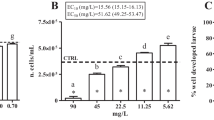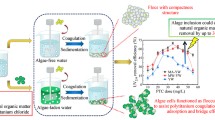Abstract
The interaction of tourmaline mineral powders with de-ionized water and seawater and the inhibiting growth activity of marine bacteria and diatoms were investigated. The results show that negative ion release rate of tourmaline powders are somewhat reduced immersing in seawater for 24h. When tourmaline powders is added into de-ionized water or seawater, electric conductivity of the de-ionized water is increased with time under the static state, their pH tend to be 7, solution oxygen of de-ionized water keeps to be about 139% of the initial 4.9mg/L and solution oxygen of seawater tends to be its initial value under stirring. For the capability of inhibiting the growth activity of marine bacteria and diatom, lithium tourmaline is the strongest in the three type of tourmaline powders with similar size, magnesium tourmaline is slightly lower than lithium tourmaline, but iron tourmaline is extremely lower than the other two types. The capability of inhibiting the microbe activity increases with reducing the size of tourmaline particles and adding the content of tourmaline powders. Tourmaline mineral materials are prospective to use as an additive to antifouling coatings from this work.
Access this chapter
Tax calculation will be finalised at checkout
Purchases are for personal use only
Preview
Unable to display preview. Download preview PDF.
Similar content being viewed by others
References
Barton, R.J.: Refinement of the crystal structure of buergerite and the absolute orientation of tourmaline. Acta Crystallogr 1969, B25, 1524–33.
Setkova, T.; Shapovalov, Y.; Balitsky, V.: Growth of tourmaline single crystals containing transition metal elements in hydrothermal solutions. Journal of Crystal Growth 2011, 318 (1), 904–907.
Yeh, J.T.; Hsiung, H.H.; Wei, W.; Zhu, P.; Chen, K.N.; Jiang, T.: Negative air ion releasing properties of tourmaline/bamboo charcoal compounds containing ethylene propylene diene terpolymer/polypropylene composites. J. Appl. Polym. Sci 2009, 113, 1097–1110.
Song, S.H.; Kang, M.: Decomposition of 2-chlorophenol using a tourmaline photocatalytic system. J. Ind. Eng. Chem 2008, 14, 785–791.
Yeredla, R.R.; Xu, H.F.: Incorporating strong polarity minerals of tourmaline with semiconductor titania to improve the photosplitting of water. J. Phys. Chem 2008, C112, 532–539.
Wang, Y.; Yeh, J.T.; Yue, T.J.; Yao, R.X.; Shen, X.Y.: Surface modification of superfine tourmaline powder with titanate coupling agent. Colloid Polymer Science 2006, 284, 1465–1470.
Leonard, D.T.; Yu, M.H.; Kim, C.H.; Lee, Y.C.; Lee, D.H.; Kim, D.W.; Kim, C.S.: Mitigation of scaling in heat exchangers by physical water treatment using zinc and tourmaline. Applied Thermal Engineering 2011, 31, 2025–2031.
Jiang, K; Sun, T.H.; Sun, L.N.; Li, H.B.: Adsorption characteristics of copper, lead, zinc and cadmium ions by tourmaline, Journal of Environmental Sciences 2006, 18 (6), 1221–1225.
Qiu, S.; Ma, F.; Wo, Y.; Xu, S.W.: Study on the biological effect of tourmaline on the cell membrane of E. coli. Surf. Interface Anal 2010.
Qiu, S.; Xu, S.W.; Ma, F.; Yang, J.X.; Lv, X.L.:. The biological promotion effect of a new biological promotive ceramsite. J. Wuhan Univ. Technol. 2010, 25 (4), 604–608.
Yao, Z.T.; Xia, M.S.; Zhang, H.M.; Hu, C.H.: Effect of tourmaline on growth in nitrifying bacteria and formation and maturation of biofilm. Fisheries Sci 2007.26 (8), 461–464.
Jin, H.M.; Hang, G.B.; Zhang, G.P.; Effects of tourmaline on the proliferation of human endothelial cells using millicell membrane culture dish. J. China Microcircul 2003, 7, 309–311.
Zhang, S.; Li, A.; Cui, D.; Duan, S.; Yang, J.; Ma, F.; Shi, S.; Ren, N.: Biological improvement on combined mycelial pellet for aniline treatment by tourmaline in SBR process. Bioresource technology 2011, 102, 9282–5.
Ruan, D.; Zhang, L.N.; Zhang, Z.J.; Xia, X.M.: Structure and properties of regenerated cellulose/tourmaline nanocrystal composite films. J. Polym. Sci. Pol. Phys 2004, 42, 367–373.
Liang, J.S.; Meng, J.P.; Liang, G.C.; Feng, Y.W.; Ding, Y.: Preparation and photocatalytic activity of composite films containing clustered TiO2 particles and mineral tourmaline powders. T. Nonferr. Metal. Soc. 2006, 16, S542–S546.
Tijing, L. D.; Ruelo, M. T. G.; Amarjargal, A.; Pant, H. R.; Park, C.-H; Kim, D. W.; Kim, C. S.: Antibacterial and superhydrophilic electrospun polyurethane nanocomposite fibers containing tourmaline nanoparticles. Chemical Engineering Journal 2012, 197, 41–48.
Amarjargal, A.; Tijing, L. D.; Ruelo, M. T. G.; Park, C.-H.; Pant, H. R.; Vista Iv, F. P.; Lee, D. H.; Kim, C. S.: Inactivation of bacteria in batch suspension by fluidized ceramic tourmaline nanoparticles under oscillating radio frequency electric fields. Ceramics International 2013, 39, 2141–2145.
Tijing, L. D.; Amarjargal, A.; Jiang, Z.; Ruelo, M. T. G.; Park, C.-H.; Pant, H. R.; Kim, D.- W.; Lee, D. H.; Kim, C. S.: Antibacterial tourmaline nanoparticles/polyurethane hybrid mat decorated with silver nanoparticles prepared by electrospinning and UV photoreduction. Current Applied Physics 2013, 13, 205–210.
Hideaki Nogami: Additive for antifouling paint. United States Patent 6001157, 1999
Rosenhahn, A.; Ederth, T.; Pettitt, M. E.: Advanced nanostructures for the control of biofouling: The FP6 EU Integrated Project AMBIO. Biointerphases 2008, 3, IR1–5.
Almeida, E.; Diamantino, T. C; de Sousa, O.: Marine paints: The particular case of antifouling paints. Progress in Organic Coatings 2007, 59, 2–20.
Chambers, L. D.; Stokes, K. R.; Walsh, F. C.; Wood, R. J. K.: Modern approaches to marine antifouling coatings. Surface and Coatings Technology 2006, 201, 3642–3652.
Chelsea M. Magin, S. P. C. A. B. B.: Non-toxic antifouling strategies. materials today 2010, 13, 36–44.
Tijing, L. D.; Amarjargal, A.; Jiang, Z.; Ruelo, M. T. G.; Park, C.-H.; Pant, H. R.; Kim, D.-W.; Lee, D. H.; Kim, C. S.: Antibacterial tourmaline nanoparticles/polyurethane hybrid mat decorated with silver nanoparticles prepared by electrospinning and UV photoreduction. Current Applied Physics 2013, 13, 205–210.
Author information
Authors and Affiliations
Editor information
Editors and Affiliations
Rights and permissions
Copyright information
© 2013 TMS (The Minerals, Metals & Materials Society)
About this paper
Cite this paper
Qi, Y., Zhang, Z., Li, W. (2013). Interaction of Tourmaline Mineral Powders with Sea Water and Its Anti-Microbial Properties. In: Marquis, F. (eds) Proceedings of the 8th Pacific Rim International Congress on Advanced Materials and Processing. Springer, Cham. https://doi.org/10.1007/978-3-319-48764-9_30
Download citation
DOI: https://doi.org/10.1007/978-3-319-48764-9_30
Publisher Name: Springer, Cham
Print ISBN: 978-3-319-48586-7
Online ISBN: 978-3-319-48764-9
eBook Packages: Chemistry and Materials ScienceChemistry and Material Science (R0)




